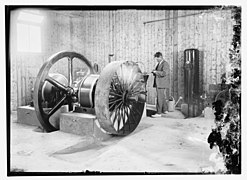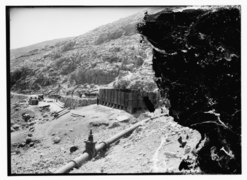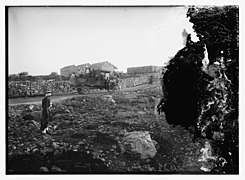Ein Farah



Ein Farah or 'Ayn Fara (
Ein Farah is the uppermost and largest of Wadi Qelt's three perennial springs.[2] In Hebrew the entire stream is called Prat; in Arabic though, each sections has its own name, according to the respective spring; the upper section is called Wadi Farah after 'Ayn Farah.[2]
The spring's water has been collected and sent downstream by aqueducts during several historical periods since antiquity, and was even used to supply water to Jerusalem, some 450 metres uphill, between 1926 and 1970.
History
Ein Farah supplied water to the surrounding area since ancient times. In the Hellenistic period an aqueduct was built for the first time, to carry the water for a long distance.
Hellenistic and Roman periods
Several aqueducts have been found originating from the spring, the oldest dating to the
Byzantine period
To the east of the spring the remains of aqueducts from the
Late Ottoman period
In the late
In the end of the 19th century the Ottoman authorities in Palestine searched for an additional major water resource for the quick developing city of
British Mandate waterworks
Six months after the British occupied Jerusalem, following the Battle of Jerusalem in December 1917, work started on the building a water supply system from the Al-Arroub springs, a 4-inch pipe was laid to a water pool in Romema in West Jerusalem.[6] The company started working on the Ein Farah Waterworks project in April 1926.[7] But the amount of water supplied was not sufficient for the needs of the growing city.[6] In February 1926 the British company Sir John Jackson Ltd. acquired the concession to supply water and electricity to the city from Euripide Mavrommatis.[6]
The work on the Ein Farah Waterworks project included the construction of three pumping stations, a 6-inch pipeline and a water reservoir at the
After 1967
The area around the spring was declared a nature reserve in 1968, was fenced and requires entry fees.[9]
In 1970, the city Jerusalem was connected to Israel's national water system, and pumping from the spring was stopped. The remains of the Mandate-era pumping station and pipes can still be seen within the nature reserve.[1]
The area of the nature reserve was increased to 28,000 dunam in 1988, and access of the local Bedouin shepherds to the spring has been blocked.[10][11]
The cliffs around the spring are a popular climbing destination.[12]
Gallery
-
Construction of the Ein Farah Waterworks 1926
-
Pumping station under construction for the Ein Farah Waterworks
-
One of the Ein Farah Waterworks pumping station, shortly after completion in 1927
-
Access road that was built during work on the Ein Farah Waterworks
-
construction of a water storage tank for the Ein Farah Waterworks 1926
-
Water pipes being laid for the Ein Farah Waterworks 1926
-
Water pipes being carried in Jerusalem for the Ein Farah Waterworks 1926
-
a "Sir Joh Jackson Ltd." truck during the construction of the Ein Farah Waterworks 1926
-
The opening ceremony of theFrench HillReservoir 15 July 1926 (The sign is in English, Arabic and Hebrew)
-
Mayor of Jerusalem Raghib al-Nashashibi at the opening ceremony
-
High Commissioners for Palestine and Transjordanspeaking at the opening ceremony
-
Gate erected for the opening ceremony
-
A tool used in the opening ceremony baring the name of Viscount Plumer
References
- ^ a b c d "En Prat Nature Reserve". Israel Nature and Parks Authority. Retrieved 24 April 2021.
- ^ a b c "En Prat Nature Reserve". allAboutJerusalem.com. Retrieved 24 April 2021.
- ^ Gruber, Angela (3 April 2015). "In the occupied West Bank, even hiking is political". +972 mag. Retrieved 2 March 2016.
- ^ "Jericho - The Winter Palace of King Herod - Jewish Virtual Library". jewishvirtuallibrary.org.
- ^ a b c d e f g h Lemire, Vincent. "Water in Jerusalem at the End of the Ottoman Period (1850-1920): Technical and Political Networks". Bulletin du CRFJ (7 (Autumn 2000)). Centre de recherche français à Jérusalem: 129-143. Retrieved 23 April 2021.
- ^ a b c JERUSALEM TO HAVE WATER - The Palestine Bulletin, 21 February 1926
BRITISH COMPANY TO ERECT MODERN WATER SUPPLY SYSTEM IN JERUSALEM - The Reform Advocate, 20 February 1926 - ^ PALESTINE FROM DAY TO DAY - The Palestine Bulletin, 16 April 1926
- ^ News article about the opening ceremony (In Hebrew) , Haaretz, 15 July 1926
- ^ Rinat, Zafrir (25 July 2003). "Wadi Qelt Squatter Works as Preserve's Inspector". Haaretz. Retrieved 31 July 2019.
- ^ Rinat, Zafrir (16 November 2004). "MK's Daughter to Be Booted From Nature Reserve". Haaretz.
- ^ Hass, Amira (13 October 2018). "How Settlers Use Flocks of Sheep to Take Over Palestinian Land". Haaretz.
- ^ Ein Farah, Sport climbing - theCrag
External links
- En Prat Nature Reserve, at the Israel Nature and Parks Authority website. Accessed 24 April 2021.
31°49′57.457″N 35°18′24.566″E / 31.83262694°N 35.30682389°E













